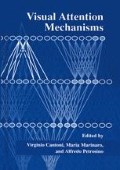Abstract
From the earliest days of academic psychology, the role of attention in perception has been one of the major foci of research and cognitive modelling (see Yantis1, William James 2). Many experiments with normally-sighted subjects have shown that attention can facilitate (visual) perception (see for example Parasuraman 3). Attended stimuli are more easily detected, reaction time is generally faster than to unattended items in a visual display, and discrimination of similar stimuli is also facilitated 4,5,6. Thus, results from a large number of behavioural studies as well as physiological and imaging experiments in humans and animals indicate that perceptual thresholds are reduced by focusing attention at a certain class of stimuli. Moreover, attention seems to exert its beneficial influence especially when perception is difficult for the individual. Ambiguous or unclear perceptual conditions may occur for different reasons: On the one hand, they may be caused by unfavourable physical stimulus characteristics, e.g. a low contrast of stimulus and background. On the other hand, they may be originating in lesions of the brain affecting the visual system and hence leading to visual field defects. In both cases, allocating attentional resources to a specific area of the visual field should improve perception.
Access this chapter
Tax calculation will be finalised at checkout
Purchases are for personal use only
Preview
Unable to display preview. Download preview PDF.
References
S. Yantis. Control of visual attention, in: Attention, H. Pashler, ed., Psychology Press, London (1998).
W. James. The Principles of Psychology. Cambridge, Massachusetts: Harvard University Press (1890, Reprint 1981).
R. Parasuraman (Ed.). The Attentive Brain. MIT Press, Cambridge, Massachusetts (1998).
M. Corbetta, F.M. Miezin, S. Dobmeyer, G.L. Shulman, and S.E. Petersen. Selective and divided attention during visual discriminations of shape, color, and speed: Functional anatomy by Positron Emission Tomography. J. Neurosci. 11: 2383 – 2402 (1991).
M. Corbetta, F.M. Miezin, S. Dobmeyer, G.L. Shulman, and S.E. Petersen. Attentional modulation of neural processing of shape, color, and velocity in humans. Science. 248: 1556–1559(1990).
G. Tassinari, S. Aglioti, L. Chelazzi, C.A. Marzi, and G. Berlucchi. Distribution in the visual field of the costs of voluntarily allocated attention and of the inhibitory aftereffects of covert orienting. Neuropsychologia. 25: 55 – 71 (1987).
High resolution perimetry (HRP)/ Visual Restitution Training (VRT). Nova Vision Software for diagnosis of visual field defects. Nova Vision AG, Magdeburg (www.nova-vision.org), Germany, (1998).
M.I. Posner. Orienting of attention. Q. J. Exp. Psychol. 32: 3 – 25 (1980).
M.I. Posner. Attention in cognitive neuroscience: an overview. in: The Cognitive Neurosciences, M.S. Gazzaniga, E. Bizzi, I.B. Black, C. Blakemore, L. Cosmides, S.M. Kosslyn, J.E. LeDoux, J.A. Movshon, S. Pinker, M.I. Posner, P. Rakic, D.L. Schacter, J. Tooby, and E. Tulving, MIT Press, Cambridge, Massachusetts (1995).
E. Kasten, and B.A. Sabel. Visual field enlargement after computer training in braindamaged patients with homonymous deficits: an open pilot trial. Restor. Neurol. Neurosci. 8: 113–127(1995).
E. Kasten, S. Wüst, W. Behrens-Baumann, and B.A Sabel. Computer-based training for the treatment of partial blindness. Nature med. 4: 1083–1087 (1998).
Author information
Authors and Affiliations
Editor information
Editors and Affiliations
Rights and permissions
Copyright information
© 2002 Springer Science+Business Media New York
About this chapter
Cite this chapter
Poggel, D.A., Kasten, E., Müller- Oehring, E.M., Sabel, B.A. (2002). Short-Term and Long-Term Effects of Selective Visuo-Spatial Attention on Visual Field Defects in Patients With Cerebral Lesions. In: Cantoni, V., Marinaro, M., Petrosino, A. (eds) Visual Attention Mechanisms. Springer, Boston, MA. https://doi.org/10.1007/978-1-4615-0111-4_18
Download citation
DOI: https://doi.org/10.1007/978-1-4615-0111-4_18
Publisher Name: Springer, Boston, MA
Print ISBN: 978-1-4613-4928-0
Online ISBN: 978-1-4615-0111-4
eBook Packages: Springer Book Archive

